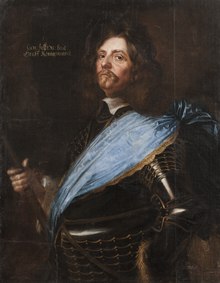Hans Christoff von Königsmarck

Count Hans Christoff von Königsmarck, of Tjust (4 March 1600 – 8 March 1663), son of Conrad von Königsmarck and Beatrix von Blumenthal,[1] was a German soldier who commanded Sweden's legendary flying column, a force which played a key role in the Swedish military strategy in the Thirty Years' War.
Biography[]
He was born in Kötzlin,[2] Altmark. After serving as a page on the court of Prince Frederick Ulrich of Wolfenbüttel, he entered Imperial military service in 1620. After the dissolution of Wallenstein's troops and Gustavus Adolphus' intervention, Königsmarck offered his services to the Swedish King. By 1635 he commanded his own regiment. He was appointed major general in 1640, governor general of Bremen-Verden in 1645, Privy Councilor in 1651 and field marshal in 1655. He is best known for the Siege of Prague between 25 June and 1 November 1648, where he managed to capture and loot the left-bank part of Prague but failed to take the Old Town until fighting ended with news of the Peace of Westphalia.[1]
During the Second Northern War, Königsmarck was captured on a sea passage to the polish front by Danzigian ships and held prisoner at Weichselmünde until the Treaty of Oliva 1660.[1]
In 1655 Königsmarck erected a castle in Lieth and named it after his wife Agathe von Leesten. The name of the castle, Agathenburg, also became the toponym of the village Lieth.[1] Their children were:
- Otto Wilhelm von Königsmarck
- Conrad or Kurt Christoph von Königsmarck, whose children were:
- Beata Elisabet von Königsmarck
He died, aged 63, in Stockholm.
References[]
- (in German) de:s:ADB:Königsmarck, Hans Christoph Graf von
Notes[]
- ^ Jump up to: a b c d Schulze, Heinz Joachim (1980), "Königsmarck, Hans Christoph Graf von", Neue Deutsche Biographie (in German), 12, Berlin: Duncker & Humblot, pp. 360–361; (full text online)
- ^ Kötzlin was a component of today's Kyritz
- ^ Kenneth Meyer Setton, Venice, Austria, and the Turks in the Seventeenth Century (1991), p. 296 note 3; Google Books.
External links[]
- 1605 births
- 1663 deaths
- People from Kyritz
- Field marshals of Sweden
- Governors-General of Sweden
- Members of the Privy Council of Sweden
- Swedish people of the Thirty Years' War
- German emigrants to Sweden
- Swedish people of German descent
- Swedish nobility
- People from the Margraviate of Brandenburg
- 17th-century Swedish military personnel
- 17th-century Swedish politicians